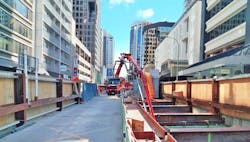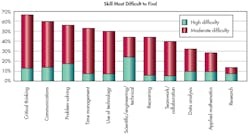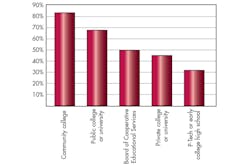Engineering Talent Pool in Peril as Nations Abroad Comb U.S.
Jobs! It’s repeated by every politician, with reshoring and new innovation offering the promise of more jobs in the U.S. But what happens when we have the jobs, but no one is qualified?
In 2011, 600,000 jobs went unfilled due to the skills gap. “We are seeing jobs coming back in manufacturing,” says Chauncy Lennon of JPMorgan Chase. “But they are advanced manufacturing jobs that require a high school degree and some type of post-secondary training.”
Low-skilled jobs are shrinking, mainly due to technology. However, the skilled job market is growing. Deloitte —an audit, consulting, and financial advisory company—published that 3.5 million manufacturing jobs will become available from 2015 to 2025, and about 2 million of them will go unfilled due to a skills gap.
“Getting people interested in these careers is challenging—especially young people,” says Bruce Hamm of the Manufacturers Association of Central New York (MACNY). “Historically, over the last few decades, we’ve had so much manufacturing leave New York because of offshoring; we were one of the rust belt states. The fact that modern manufacturing has changed the whole equation hasn’t penetrated to the public, the schools, the kids, or the parents for that matter.”
Talent acquisition in companies is a key role that will only become more difficult over time. As people talk about reshoring and growing the job market, it is imperative people are able and qualified to fill those jobs. Politicians and companies should be as concerned about education and training as they are about growing jobs. However, this problem is not restricted to the U.S.
Germany
Germany, a strong economic and engineering powerhouse, failed to find 1.1 million skilled workers and professionals in the third quarter of 2017. In an economic upswing, there is a shortage of young talent to meet the high demand for labor. Now German companies are urgently looking for talent from all over the world.
Recruitment has been streamlined with the Employland platform. Here, skilled employees from all over the world create their own personal profiles and are immediately provided with initial legal information about their profession, visa regulations, and residence permits. German employers use the platform to look for new employees and try to attract the attention of job seekers. In addition to helping with job placement, Employland takes care of all legal formalities related to residence and employment permits as well as recognition of qualifications.
However, not having any ability to speak or understand German language will be a problem. Some employers understand there will be a learning curve before a prospective employee becomes fluent, but having no understanding of the language will hurt your chances. So where do you go if you are looking for work, want a new location, but don’t speak German?
New Zealand
This English-speaking country is also searching for international help in filling its skills gap. After a five-year national audit on the country’s infrastructure, New Zealand is undergoing the biggest infrastructure build in the nation’s history. As such, a group of private companies and government organizations has launched a campaign seeking engineers.
Three of the projects underway or nearly underway in the country are:
- Taiwhanga Rehia – Slated for construction in the city of Christchurch, the finished facility will be New Zealand’s largest indoor public recreation venue. At over 30,000 square meters, the Metro Sports Facility would feature a 10-lane competition pool, separate diving pool, large aquatic leisure area, five hydroslides, fitness spaces, and nine indoor courts for sports such as netball, volleyball and basketball. It is designed to attract people of all ages and fitness levels to a city experiencing a building renaissance as it continues to recover from a series of quakes in 2011.
- Transmission Gully Motorway – Currently under construction and leading toward the nation’s capital of Wellington, the 27-km, four-lane motorway is designed to meet demanding specifications. The NZ$850 million (on 12/15, NZ$1 = US$0.70) project is scheduled for completion in 2020. It will significantly reduce traffic through nearby communities, and be able to resist and recover from earthquakes and storms.
- Auckland City Rail Link – Currently under construction in the nation’s largest city, City Rail Link is the largest single infrastructure project ever undertaken by New Zealand. Scheduled for completion in 2023, the project dramatically expands the city’s current rail system and will relieve growing capacity concerns for other forms of public transportation in Auckland.
And New Zealand wants U.S. talent. The country’s Immigration is rolling out a dedicated initiative to attract U.S. talent with specific in-demand skill sets beyond the construction and engineering sectors. More information is available at NZNow.com.
The new Labor-led Government is introducing a special “KiwiBuild” fast-track visa system to facilitate the search for top construction talent, spearheaded by an innovative international recruitment campaign called LookSee Build New Zealand.
A construction team pours the concrete at the bottom of future rail tunnels, which are part of New Zealand’s massive infrastructure plan. Work started on December 21, 2015. It's taken the workers approximately 501,000 hours to get to this point. So far, 30,000 cubic meters of soil and rock have been removed and filled up a double trailer-truck 1,866 times.
LookSee Build NZ is a consortium of private companies, local body entities, and government organizations. The aim of the campaign is to attract some of the more than 56,000 construction and engineering staff, including 2,200 high-end specialist positions, that New Zealand needs for the more than NZ$125 billion program of infrastructure works over the next decade.
Prime Minister Jacinda Ardern has also announced a new NZ$2 billion housing program that aims to construct 10,000 homes a year for 10 years, as well as a program of infrastructure works in addition to the existing pipeline.
Looksee Build spokesman and construction consultant Aaron Muir says it is the first time New Zealand’s public and private construction sector have combined in a single cause. However, the need for top talent is so acute, such an innovative approach was required in order to procure talent.
The Metro Sports Facility is intended to be the largest aquatic and indoor recreation and leisure venue of its kind in New Zealand. It would be accessible to people of all ages, abilities and skill levels.
Engineers, particularly in the areas of geotechnical, seismic, civil, and structural, are at top of New Zealand’s shopping list. That’s because the Christchurch and Kaikoura earthquakes triggered a nationwide seismic audit of buildings, and significant compliance issues arose with historic buildings around the country.
But a broad range of specialist skills are required across the board. So the campaign is offering a sweetener to entice Americans to migrate with a range of quintessential “Kiwi experiences,” such as fishing, surfing, and canoeing safaris; cultural events; and the chance to see stunning sites of natural beauty, says Muir.
United States
The U.S. is having its own talent-acquisition problems, beyond the fact that other countries are trying to lure skilled employees. A published report from the Public Policy Institute of New York State Inc. states that, “While shortages in professional skills were most pervasive, employers reported that STEM-specific skills and qualifications were the toughest to find. Almost a quarter of executives reported ‘high difficulty’ finding candidates with the necessary scientific, engineering, and technical skills. Half reported moderate or high difficulty finding candidates skilled in using technology, and close to 30 percent reported moderate or high difficulty finding candidates with other STEM skills such as data analysis and applied math.
“This is consistent with previous research; for example, on the 2014 Public Policy Institute survey, more than half of employers reported difficulty finding workers with data analysis and applied math skills, and more than 20 percent of employers found it ‘very difficult’ to do so. Similarly, a 2014 nationwide survey by the Business Roundtable and Change the Equation found that CEOs had particular difficulty finding candidates with STEM skills.”
Employers are having difficulty finding prospective employees with these skills, and the search is expected to become even more problematic over time. In fact, people are retiring faster than those graduating with these skills. Thus, companies need to get creative in filling these positions, or they will have to go another route—outsourcing, automation, etc.
Many of these skills do not require a four-year degree. A number of employers are looking for plumbers, welders, and those with heating, air-conditioning, and ventilation skills. If you have ever seen the TV show Dirty Jobs, the host is now passionately running the Mike Rowe Works Foundation. The site reads “The mikeroweWORKS Foundation is a 501(c)(3) public charity that rewards people with a passion to get trained for skilled jobs that actually exist. As CEO of the Foundation, Mike Rowe spends a significant amount of time speaking about the country’s dysfunctional relationship with work, highlighting the widening skills gap, and challenging the persistent belief that a four-year degree is automatically the best path for the most people.”
Research from the Public Policy Institute mentions employers aren’t always looking for university degrees. According to its survey, community colleges are a great resource.
Ten of New York’s largest employers were asked: “Which education/training partner(s) is your company most interested in?” While certification classes and tech schools are popping up, it is important for students to make sure the program they are in is recognized by a potential employer.
Some states, such as Vermont, have already started policies to combat the skilled-employee shortage. Two policies focus on training and talent acquisition. Vermont’s representative says, “It is no secret that our education and workforce system is facing challenges to keep pace with our economy. Employers struggle with finding skilled workers who can contribute to economic growth and competitiveness, and a disconnect exists between what employers need and what prospective employees are prepared for. Vermont Talent Pipeline Management (VTPM) is a two-phased approach to rethinking the development and sourcing of Vermont’s future workforce. Leveraging lessons learned from supply-chain management, VTPM expands the role of employers as end-customers of education and workforce systems.”
The state also offers a training program. It leverages a grant budget to serve Vermonters across a broad range of industry sectors, while putting a focus on new and innovative training projects or initiatives. The program can fund pre-employment, new hires, and/or incumbent employee training. Up to 50% of wages for each employee in training (on-site training) or up to 50% of the trainer expenses (classroom/vendor fees) can be funded.
Festo Didactic is an industrial education service with the ability to equip technical training institutes or offer training and consultancy to industrial processing companies.
Currently, it looks like the jobs and the resources exist, but we are failing on execution. Any company or government that’s able to find an effective way to get unskilled-workers into the right programs to fill the right jobs will find a large and growing market. In fact, many programs are already working on this issue, such as Festo’s Didactic Training.
If you know of any training programs that might help an unskilled worker get a higher-skilled position, comment below or email me at [email protected]. Also, if you have a list of skills that you are having a hard time finding in the current market, feel free to send that as well.






